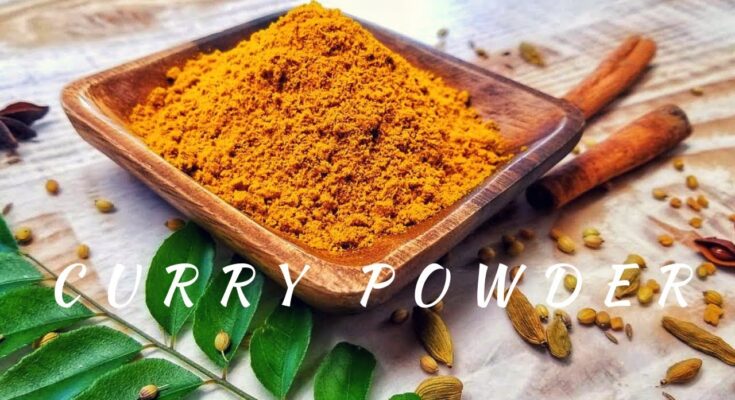Curry Powder Recipe: Curry powder is a vibrant blend of spices that brings warmth, depth, and an unmistakable aroma to dishes. Contrary to popular belief, curry powder is not a traditional Indian invention but a British colonial adaptation of Indian spice blends, designed to bring the essence of Indian cooking to the Western kitchen in a simple, ready-to-use form. It typically includes spices like turmeric, cumin, coriander, and fenugreek, each adding a unique note to the final flavor.
Why Make Your Own Curry Powder?
Why go the DIY route when store-bought curry powder is just a grocery aisle away? Well, the answer lies in freshness, customization, and control. Homemade curry powder is like tailoring a suit—it fits your taste preferences perfectly. Store-bought options often sit on shelves for months, losing their punch and depth. When you make your own, you choose the spices, you control the proportions, and you get to enjoy the rich, intense flavors that only fresh grinding can deliver.
Ingredients for Homemade Curry Powder
Basic Ingredients List
Here’s a tried-and-true list of ingredients to get you started with a classic curry powder:
- 2 tablespoons coriander seeds
- 1 tablespoon cumin seeds
- 1 tablespoon turmeric powder
- 1 tablespoon ground ginger
- 1 tablespoon fenugreek seeds
- 1 teaspoon mustard seeds
- 1 teaspoon black peppercorns
- 1 teaspoon cinnamon powder
- 1 teaspoon paprika or chili powder (for heat)
These ingredients are your flavor foundation—warm, earthy, aromatic, and slightly spicy. Each one contributes a layer to the overall profile of the curry powder.
Optional Add-ins for Personal Touch
Want to make it your own? Try adding:
- Cloves for more warmth
- Cardamom pods for a sweet, exotic note
- Nutmeg for a deeper aroma
- Dried curry leaves for authenticity
- Fennel seeds for a slightly sweet, licorice twist
Creating curry powder is a bit like painting. The basics are your canvas, but it’s the little extras that turn it into a masterpiece.
Equipment You’ll Need
To craft your homemade curry powder, you don’t need a full-blown spice factory. Just a few tools from your kitchen will do the job:
- A skillet or frying pan – for toasting the spices
- A spice grinder or coffee grinder – to grind everything into a fine powder
- A fine mesh sieve – to sift and remove any coarse bits
- A glass jar with a tight lid – for storing your finished powder
If you’re a purist or love traditional methods, a mortar and pestle works great too—just be ready for a mini workout!
Step-by-Step Guide to Making Curry Powder
Step 1 – Gather Your Ingredients
Start by assembling all your spices. Measure them accurately and place them in small bowls. It might sound like a basic step, but trust me, once you start toasting, you don’t want to be running around searching for cumin seeds.
Step 2 – Toast the Whole Spices
Place the whole spices (like coriander seeds, cumin seeds, mustard seeds, fenugreek, and peppercorns) in a dry skillet over medium heat. Toast them for about 2–3 minutes, stirring constantly to avoid burning. You’ll know they’re ready when they become fragrant—your kitchen will smell like a spice market.
Toasting helps to release the essential oils in the spices, making your curry powder much more flavorful and aromatic.
Step 3 – Grind the Spices
Once toasted, let the spices cool slightly. Transfer them to your spice grinder or coffee grinder. Add the powdered spices (like turmeric, ginger, and cinnamon) and grind everything together until fine. If needed, sift the mixture to ensure it’s smooth and uniform.
Tips for the Best Homemade Curry Powder
Use Fresh Spices
This can’t be stressed enough—fresh spices are everything when it comes to flavor. If your spices have been sitting in the back of your cupboard for years, chances are they’ve lost most of their potency. Use recently purchased whole spices whenever possible. Whole spices retain their oils and flavors longer than pre-ground ones. Grinding them yourself just before mixing creates a powerful, fragrant curry powder that makes a noticeable difference in your dishes.
A quick freshness check? Crush a small amount between your fingers. If it smells strong and vibrant, it’s good to go. If it’s faint or musty, it’s time for a refresh.
Adjust to Your Taste Preferences
Not all curry powders are created equal—some people like it fiery hot, others prefer a mellow, fragrant blend. That’s the beauty of making it yourself. Want more heat? Add extra chili powder or cayenne. Looking for a sweeter note? Toss in a pinch of cinnamon or fennel seeds. Craving depth? A little clove or nutmeg can work wonders.
Play around with proportions. Start with a basic recipe and tweak as needed after a taste test. Remember, the best curry powder is the one that excites your taste buds.
How to Store Curry Powder
Storing your homemade curry powder correctly is just as important as making it right. Exposure to air, light, and moisture can quickly degrade the flavor and aroma. Here’s how to keep your blend fresh and punchy:
- Use an airtight glass jar – preferably dark-colored to block light.
- Store in a cool, dark place – a pantry or kitchen cupboard works great.
- Avoid the fridge or freezer – the moisture can cause clumping and spoilage.
Label the jar with the date you made it. For best results, use your curry powder within 3 to 6 months. It won’t go bad right away, but it’ll slowly lose its intensity. A quick sniff will usually tell you if it’s still up to the task.
Common Uses of Curry Powder in Cooking
Homemade curry powder isn’t just for making curry. It’s a multi-purpose spice blend that can jazz up a wide variety of dishes. Here are some delicious ways to use it:
- Curries and stews – the obvious choice! Add it to chicken, lamb, beef, or veggie curries for a rich, authentic taste.
- Soups and broths – a spoonful can transform a plain soup into something exotic and exciting.
- Marinades and rubs – mix curry powder with yogurt or oil to marinate meats or as a dry rub before grilling.
- Rice and grains – stir it into basmati rice or couscous for a colorful, flavorful side.
- Egg dishes – sprinkle into scrambled eggs or omelets for a spicy morning kick.
- Roasted veggies – toss potatoes, cauliflower, or carrots with olive oil and curry powder before baking.
The possibilities are endless. Curry powder is one of those pantry staples that, once you start using, you’ll wonder how you ever cooked without it.
FAQs About Curry Powder Recipe
1. What is curry powder made of?
Curry powder is typically a blend of spices such as turmeric, cumin, coriander, ginger, and chili powder. Some versions may also include fenugreek, cinnamon, cloves, and garlic powder for added depth.
2. Is curry powder the same as garam masala?
No, they are different. Curry powder is a general spice mix created for Western cooking, while garam masala is an authentic Indian spice blend used mainly in North Indian dishes. Both have distinct flavor profiles.
3. Can I make curry powder at home?
Absolutely! Homemade curry powder allows you to customize the spice level and flavor. Just mix common ground spices like turmeric, coriander, cumin, and paprika in desired proportions.
4. How should I store curry powder?
Keep it in an airtight container, away from direct sunlight and moisture. Store it in a cool, dark place to maintain its aroma and potency for up to 6 months.
5. Is curry powder spicy?
It depends on the blend. Some curry powders are mild with more turmeric and coriander, while others are hot due to chili powder or cayenne pepper.
6. What dishes can I use curry powder in?
Curry powder is versatile and can be used in soups, stews, marinades, stir-fries, rice dishes, and even salad dressings for an exotic twist.
7. Can I substitute curry powder with other spices?
If you’re out of curry powder, you can create a quick substitute using a mix of turmeric, cumin, and coriander. Adjust the blend based on your taste preference.
8. Is curry powder healthy?
Yes, curry powder contains spices like turmeric and ginger known for their anti-inflammatory and antioxidant properties. However, use in moderation as part of a balanced diet.
Conclusion
Making your own curry powder is one of those simple kitchen projects that pays off big time. Not only do you get fresher, bolder flavors, but you also gain the power to tweak it to your exact taste. Whether you’re a spicy food fanatic or someone who enjoys warm, mild flavors, crafting a homemade spice blend brings a level of personalization that store-bought versions just can’t match.
Plus, there’s a certain satisfaction in knowing that the mouthwatering aromas in your kitchen came from a blend you created with your own hands. Give it a shot—you might never go back to the pre-made stuff again.



